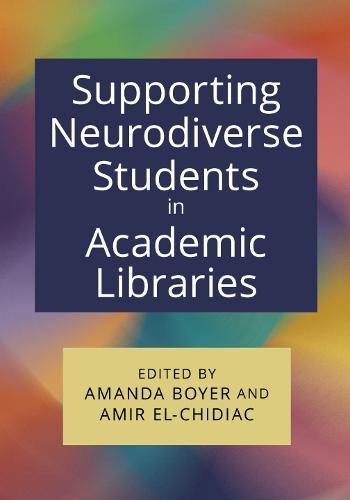Overview
Neurodiverse students encounter myriad barriers and hurdles to thriving in academia, and there is an increasing need for all types of accessibility in our libraries. Librarians and educators working in academic institutions can partner with neurodiverse students to help them flourish on campus and establish community. In five parts, Supporting Neurodiverse Students in Academic Libraries offers practical advice that can be easily implemented and scaled to various types, sizes, and budgets of libraries. Instruction Services Cross-Campus Collaborations Resources Spaces Chapters include effective practices for students with autism spectrum disorder, brain trauma, and PTSD, but also depression, anxiety, and other mental health disorders. Supporting Neurodiverse Students in Academic Libraries demonstrates the power of working alongside students to create welcoming spaces, services, and resources that can help all students succeed.
Full Product Details
Author: Amanda Boyer , Amir El-Chidiac
Publisher: Association of College & Research Libraries
Imprint: Association of College & Research Libraries
Weight: 0.454kg
ISBN: 9798892555975
Pages: 384
Publication Date: 30 October 2025
Audience:
College/higher education
,
Tertiary & Higher Education
Format: Paperback
Publisher's Status: Active
Availability: In Print 
This item will be ordered in for you from one of our suppliers. Upon receipt, we will promptly dispatch it out to you. For in store availability, please contact us.
Table of Contents
Introduction Part I: Instruction Chapter 1 Words, Pain, and Empowerment: Naming Neurodiversity — Elizabeth Pineo Chapter 2 Designing Library Instruction that is Inclusive of Neurodiverse Learners Through Application of a Universal Design Framework — Sheryl Burgstahler, Ph.D. Chapter 3 Empathetic Pedagogy: Fostering Inclusivity in Library Instruction for Neurodiverse Learners — Amanda Larson and Hanna Primeau Part II: Services Chapter 4 Library Services for Students with Post-Traumatic Stress Disorder — JJ Pionke Chapter 5 Helping Neurodiverse Students by Accepting Ourselves: Creating an Inclusive Atmosphere for Neurodiverse Library Workers — Ian Ross Hughes, Rose Melonis, and Rachel Menzel Chapter 6 Developing a Library Student Employee Training Program to Improve Interactions with Neurodiverse Students — Sherry Packard and Connie Strittmatter Chapter 7 New York University’s Accessibility and Accommodations Librarian — Lauren Kehoe Part III: Cross-Campus Collaborations Chapter 8 Supporting the Success of the Neurodivergent Student: Creating Accessible and Inclusive Library Resources, Services, and Spaces — Dawn Behrend Chapter 9 Sustainable Cross-Campus Collaborations to Support Library-Based Sensory Social Justice — Brett Spencer, Meghan B. Owenz, and Deniz Aydemir-DÖke Chapter 10 Confident Collaborations: Working Together to Offer Library Group Tours — Amy Dye-Reeves Chapter 11 Fostering Success: How Cross Campus Partnerships Can Improve Accessibility, Engagement, and Inclusion for Autistic Undergraduate Students — Mercedes Rutherford-Patten and Luna Nombrano Larsen Chapter 12 When Two Plus Two Isn’t Four: Supporting Students with Learning Disabilities — Haley Dittbrenner Part IV: Resources Chapter 13 Developing Academic Library Resources for Neurodiverse Students: A Multi-Faceted Approach at West Chester University — Gary M. Childs and Kerry Walton Chapter 14 Designing for Neurodiversity in Web Spaces — Kelly Getz and Kimberly Shotick Chapter 15 Supporting Neurodivergent Students in Archives and Special Collections — Colleen Hoelscher Chapter 16 Taking Steps Toward Improved Library Service for Neurodiverse Students: Projects and Initiatives at the University of Iowa Libraries — Rita Soenksen Chapter 17 It’s More than the Building: An Autistic Librarian’s Perspective on Library Accessibility — Mary Catherine “Cat” Ellis Part V: Spaces Chapter 18 “I Need Some Space:” Creating Library Spaces That Work for Everyone — Alison Downey and Rachael Muszkiewicz Chapter 19 Failing to Plan is Planning to Fail: Neurodiversity as a Planning Component for Library Spaces — Micki Dietrich, Ian Ross Hughes, Rose Melonis, and Rachel Menzel Chapter 20 Creating a Comforting, Welcoming Environment for All — Gretchen Dreimiller Chapter 21 Alone, Together: Designated Quiet Spaces in Academic Libraries — Amy Deuink Chapter 22 Installing a Sensory Space at New York University Libraries: Planning, Inclusive Research, Partnerships, and Impact — Harini Kannan, Lauren Kehoe, and Lisa Gayhart About the Editors and Authors
Reviews
Author Information
Amanda Boyer is the student success librarian at Susquehanna University, where she has worked since 2021 and also earned her undergraduate degree. She holds an MLIS from Kent State University (2020) and has experience in medical, public, and academic libraries. Her research focuses on accessibility, neurodivergence, social justice in libraries, and supporting first-year students. She has published several research articles and a book chapter, and has presented her work at numerous conferences and workshops. This book extends her ongoing efforts to create accessible library spaces for neurodivergent students, a mission she continues to pursue in collaboration with the university's Counseling and Psychological Services' Neurodivergent and Autism Spectrum Therapy Group and the newly founded Autism Student Union. Amir EI-Chidiac is a librarian and instructor at the Community College of Philadelphia. Formally, they were a diversity resident librarian at Susquehanna University. Amir holds an MFA from the New College of California (2007) and an MLS from North Carolina Central University (2021). Amir's academic and creative writing has been widely published. As a disabled and neurodivergent librarian, Amir is passionate about creating accessible library spaces for diverse student populations and creating a space for knowledge sharing, exploration, joy, and relaxation.
Tab Content 6
Author Website:
Countries Available
All regions
|



